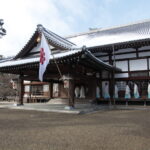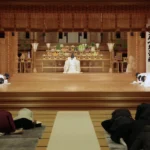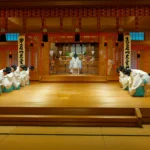from the “Oomoto International” (Apr.-Jun. 1981)
By Masamichi Tanaka
Outside the great worship hall, the icy chill of an early February evening gripped the city of Ayabe. Inside the sanctuary, in total darkness, nine thousand Oomoto believers from all over Japan sat in a state of expectancy for the grand festival of Setsubun to begin. I was one of those believers. The hall was so crowded, I could not move my elbows. In the darkness an occasional cough broke the silence. A baby began to wail.
Suddenly the entranceway began to glow with a faint light. Six priests in voluminous Heian robes and with black headgear entered the hall. They proceeded slowly in single file through the crowd, the foremost carrying the sacred flame in an enclosed box. Arriving at the altar, the priests knelt flat against the floor in an attitude of total obeisance. Then two of the priests rose and solemnly approached the altar carrying the sacred flame.
One by one the candles in the chancel received the flame and soon the candles were flickering like grains of gold. The hall began to glow with a warm light.
I was thinking with awe of the ceremony on top the mountain called Honguyama, sacred to Oomoto, where the holy flame was first sparked into being. The ritual was archaic — the same used at the grand shrines of Ise and lzumo. We all had stood behind the officiating priest, unable to see exactly what he was doing, but aware from the strenuous movements of his body of the exertion it took to strike fire with a rod from a wooden paddle.
Now all the candles were lit and the lights in the sanctuary burst into brilliant illumination. The priests rose to a kneeling position, struck their palms together ritualistically, then got to their feet, bowed to the altar and turning, left the sanctuary.
A big drum boomed into the night signaling the commencement of the Grand Festival of Setsubun. Instrumentalists in white silk robes, each carrying a two-stringed koto, proceeded to the altar in single file, seated themselves in the chancel, bowed, and struck the first plangent notes of the koto melody. To this austere music a hundred and forty priests made solemn procession through the sanctuary to the altar followed by one hundred matrons wearing snow-white kimono, representing the forces of purification. They all took their seats on a dais to the front of the chancel.
Setsubun means changing of the seasons, the foremost by far being the change from winter into spring. The ancients fixed the first day of their calendar year around the time of the advent of spring, believing that deities visited the fields to confer special blessings at this time. The accompanying invocatory rituals naturally included prayers for a bountiful harvest.
The Setsubun Festival at Oomoto is basically a ceremony for purifying the nation and the whole universe, this ritual referred to as Oharai or Great Purification. Such a ritual has been observed at the imperial court and in many shrines throughout the country from antiquity. Generally it takes place on the last day of the sixth and twelfth months.
At the great hall in Ayabe, a priest rose from his seat and took up the purification wand. Approaching the offeratory rice, vegetables, fruits, and pine branches, he purified them by waving the wand over his left shoulder, then his right shoulder, and finally back to the left shoulder with a characteristic flourish. Then turning, he purified the priests and the congregation.
Following this, fifteen priests left their seats and, accompanied by koto music and singing, started transmitting the food offerings from hand to hand – a sheaf of rice, fish, vegetables, rosy apples, gleaming oranges, melons – until they were all piled in brilliant array before the altar.
As I watched the ceremony, idle questions flitted through my mind. “Why,” I wondered, “does Oomoto perform their great purification on the day of Setsubun ? Why not New Year’s Eve like all the rest ?” As I pondered, the chief priest approached the altar, unrolled a folded paper and began reciting the invocation.
“The most august, the Creator of the heavens and the earth, deigned to quit His throne and endure seclusion in the northeast for ages unnumbered. But the time has now come. He has reappeared to redeem and to summon all creatures. Here we hold the Grand Festival to rejoice over His reappearance, to beg remission of our sins, and to pray for peace on earth.”
Indeed, Setsubun is the anniversary for the founding of Oomoto. It is the very day when Ushitora no Konjin first revealed His divine presence through the foundress, Nao Deguchi. Thus He proclaimed His return to the throne, and the beginning of the reconstruction of the Greater World.
The chief priest was now reciting prayers for a good harvest. At its conclusion, the priest and many representatives from among the worshipers entered the chancel to place ritual pine branches before the altar. These pine branches symbolized timber and silk for the construction of the heavenly shrine.
There quickly followed the prayer for the great purification. Then the sacred dance by two young maidens in gorgeous Heian robes, one holding a short purificatory wand, the other a cascade of golden bells. As they moved slowly and gracefully about the chancel, the sweet chiming of the bells mingled with the delicate twanging of the kotos. Purify ! Purify ! Purify !
The dance came to an end and the great drum gave out a solemn beat as the priest and worshipers started the chanting of a long prayer of purification. Thus began an all-night vigil as priests commenced reading out the addresses and names written on slips of rice paper called hitogata.
These hitogata were actually paper dolls. Their origins were in ancient China where people ritually purified themselves by bathing in the river on the third of March. When the Japanese took up the ritual, they substituted paper dolls for their own bodies, rubbing themselves with the dolls so that their sins and impurities would be transferred to the paper. Worshipers then threw the dolls in the river so that transgressions would be carried out to sea.
As time went on, more and more luxurious dolls replaced the simple paper ones. Thus arose Japan’s great doll cult. No one wished to throw away such exquisite artifacts, and people began displaying them instead. The Doll Festival was a natural outcome.
Over and over again I recited the prayer with the other worshipers. At last I decided to leave the hall. At the doorway I had to push my way through the throngs of worshipers crowded around the entranceway because there was no room inside. Outside a bonfire burned in a huge brazier, sending sparks upward into the dark sky. Many people stood around the fire holding out their hands to the blaze.
Nearby there was a stall where warm drink could be had. I received a bowl and sipped the drink of warm, fermented rice, sweet, and seasoned with ginger. There were mounds of snow on the ground and the snow was again softly falling. I stood by the bonfire smoking a cigarette and thinking of Onisaburo’s interpretation of an ancient legend.
There was once an Indian god, it would appear, with the head of an ox. He was the god of plagues and diseases and he became the king of Korea. On one of his campaigns he attacked a kingdom called Hiroto Kuni (Spacious Country Far Away) and invaded the palace of King Kyotan, considered a devil. He captured King Kyotan, cut his body into five pieces, and performed incantations to hold the spirit of the king in thrall. He then turned over the kingdom to one of his followers commanding him to observe the five festivals in order to ward off disease.
Onisaburo Deguchi construed this mythological episode as follows : Hiroto Kuni means Japan and King Kyotan is Ushitora no Konjin (Accursed God of the Northeast) .
Thus, throughout the ages, the Creator God suffered humiliation at the hands of lesser gods. Meanwhile He secretly watched over the world, warding off apocalypse and defending the world from ultimate annihilation.
Occasionally He sent His messengers to warn people and to teach them the truth of the spirit, of the love and goodness of God. Religions sprang up and people learned to believe in God and to rely on His mercy with prayers and offerings.
Crushing out my cigarette, I started wandering aimlessly through the grounds. Poking curiously about I finally found myself in a room behind the chancel of the main hall. Attracted by the sounds, I opened the back door behind the chancel just a crack and peeped in. Priests were reading out the hitogata while the congregation in a gathering crescendo chanted the prayer to the booming of the drum.
All of a sudden I was struck by some enormous force. As I swayed drunkenly, I could detect, by some sort of intuition, a great spiritual energy surpassing anything human, strongly working to purify all sin and contamination. I felt my body charged with a kind of transport of potency. For several minutes I stood rooted, unable to move.
Outside the snow went on falling. Snow ! Nature’s own great purifying agent. I was unaware of the passage of time. Suddenly I realized that the ceremony had entered a new stage. Hurrying to the sanctuary, I found a procession already begun. Twenty priests and one hundred matrons had started their march to the riverside, each matron carrying in her hands an unglazed jar stuffed with hitogata. Hundreds of followers accompanied the procession, their way lighted by lanterns and torches. It took thirty minutes to reach the river.
A platform had been built on the bridge extending out over the water. The Yura River looked cold and darkly green in the flickering torchlight. The matrons placed the jars on the bridge, their white robes gleaming in the night. I took my place among the worshipers lining the banks and joined in the chanting of a prayer.
As the prayer proceeded, the priests took up mallets of osmanthus wood and began shattering the jars. Like hordes of white moths, the hitogata mingled with the snowflakes, fluttered down into the sluggish waters of the Yura, and began their long voyage to the sea and expiation. I prayed for the people whose names were written on those slips of paper.
A week previously I had gone from house to house offering hitogata to the people of the neighborhood. I remember a mentally handicapped woman in her twenties who could not even answer my questions. All the while she sat smiling and turning the pages of a comic book. Her mother accepted several of the “paper dolls”.
Another woman wrote down the name of her daughter-in-law who had taken her child and run away from home. With clasped hands the old woman begged me to pray for the younger woman’s safe return.
I prayed earnestly for all the troubled people whose names were gliding out to sea. Something warm and tranquil began to fill my heart. I went on praying, staring at the falling snow.
History of Oomoto



